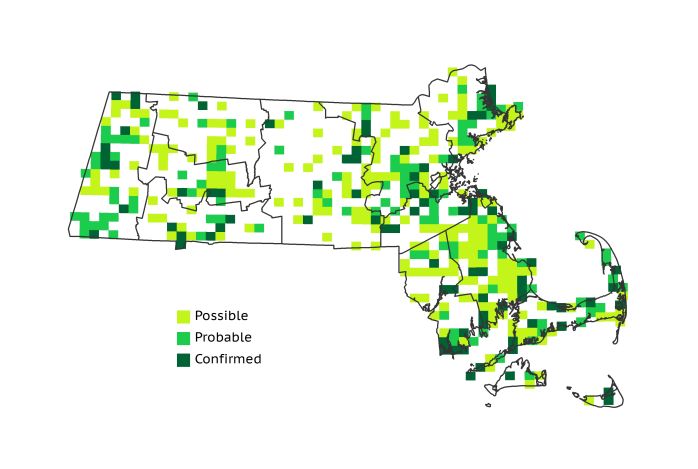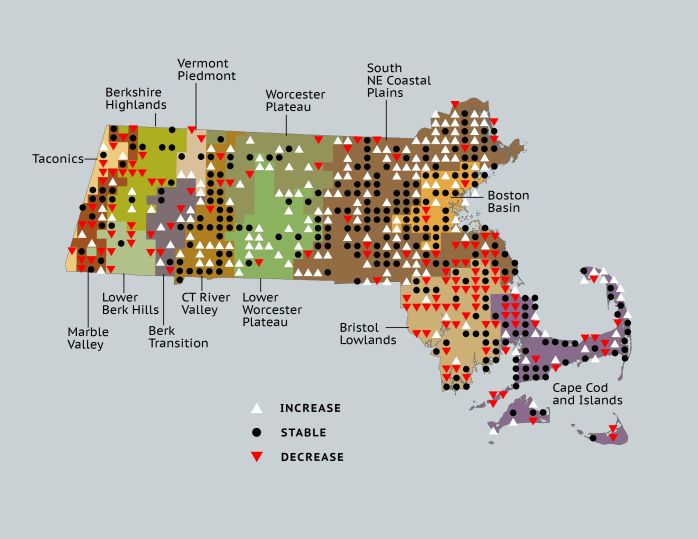Find a Bird
Green Heron
Butorides virescens

Widespread and likely increasing
Action/monitoring needed
State Wildlife Action Plan listed
“Like the Crow and Black Duck, it is at once a wary and a venturesome bird, endowed with sufficient intelligence to discriminate between real and imaginary dangers and often making itself quite at home in noisy, thickly settled neighborhoods where food is abundant and where it is not too much molested.” – William Brewster, The Birds of the Cambridge Region of Massachusetts
Widespread yet elusive, the Green Heron is one of the more familiar waders to folks who spend time in the great outdoors. These small and well-camouflaged herons will feed in swamps, ponds, rivers, lakes, human-made impoundments, estuaries, and bays with equal readiness. The only real requirement the Green Heron seems to insist upon is some modicum of cover. Indeed, this species is so adept at concealing itself that its habit of flushing suddenly from hiding with a loud squawk and a stream of white excrement has given it a number of colorful nicknames such as “skeow,” “fly-up-the-creek,” “chalk-line,” and “shite-polk.”
Historic Status
“Hardly a shallow pond or wide stream may be found in southern New England that is not visited either occasionally or frequently in spring and summer by one or more Little Green Herons,” wrote Edward Howe Forbush like a doting father (Forbush 1925). And so it had been for the previous hundred years. Southern New England, though, represents just a corner of the widespread range of the species. Unexpected habitat changes in the middle of the twentieth century, even the claiming of wetlands for development, seemed to have no visible effects on the population of Green Herons in Massachusetts by the time of Atlas 1. Sadly, those days were still to come.
Atlas 1 Distribution
Unlike most of the state’s other breeding herons, Green Herons don’t congregate into breeding colonies. Breeding was found throughout the western part of the state, and the Marble Valleys region was the only one in the area to surpass 50% block occupancy. The many ponds and rivers of the Connecticut River Valley also had Green Herons in more than half of all blocks, but the birds were recorded at lower rates across the Worcester and Lower Worcester Plateau. These relatively shy and reclusive herons were found in over a hundred blocks throughout the Coastal Plains, and surprisingly in exactly half of all Boston Basin blocks. The Bristol/Narragansett Lowlands were a particular haven for breeding Green Herons, as were the Cape and Islands ecoregions.
Atlas 2 Distribution and Change
Despite a noticeable redistribution of the population within the state, Green Herons have made notable gains in Massachusetts. The species has retreated from Bristol and Plymouth Counties, perhaps in the face of suburban sprawl, but has found suitable habitat on the Lower Worcester Plateau. Losses similar to those in the southeast took place in the west, except for the species’ stronghold in the Connecticut River Valley, but the Boston Basin and the great marshes of Essex County have apparently taken up the slack. No matter where they are, though, the fact remains that Green Herons were seen in more than 50% of the state in Atlas 2, an increase from the days of the 1970s.
Atlas 1 Map

Atlas 2 Map

Atlas Change Map

Ecoregion Data
Atlas 1 | Atlas 2 | Change | ||||||
Ecoregion | # Blocks | % Blocks | % of Range | # Blocks | % Blocks | % of Range | Change in # Blocks | Change in % Blocks |
Taconic Mountains | 6 | 37.5 | 1.4 | 4 | 16.0 | 0.7 | -2 | -13.3 |
Marble Valleys/Housatonic Valley | 26 | 66.7 | 6.2 | 21 | 53.8 | 3.9 | -5 | -12.8 |
Berkshire Highlands | 16 | 29.1 | 3.8 | 13 | 23.6 | 2.4 | -5 | -9.4 |
Lower Berkshire Hills | 8 | 28.6 | 1.9 | 2 | 6.5 | 0.4 | -6 | -22.2 |
Vermont Piedmont | 4 | 23.5 | 1.0 | 7 | 41.2 | 1.3 | 2 | 16.7 |
Berkshire Transition | 10 | 26.3 | 2.4 | 14 | 35.0 | 2.6 | 1 | 3.2 |
Connecticut River Valley | 34 | 60.7 | 8.2 | 54 | 83.1 | 10.1 | 11 | 22.9 |
Worcester Plateau | 16 | 20.5 | 3.8 | 37 | 42.0 | 6.9 | 7 | 14.6 |
Lower Worcester Plateau | 10 | 13.5 | 2.4 | 34 | 42.5 | 6.4 | 19 | 35.2 |
S. New England Coastal Plains and Hills | 123 | 45.6 | 29.5 | 197 | 69.6 | 36.9 | 48 | 21.2 |
Boston Basin | 28 | 50.0 | 6.7 | 38 | 67.9 | 7.1 | 10 | 18.2 |
Bristol and Narragansett Lowlands | 67 | 63.2 | 16.1 | 37 | 32.5 | 6.9 | -32 | -31.7 |
Cape Cod and Islands | 69 | 50.7 | 16.5 | 76 | 52.8 | 14.2 | 2 | 1.7 |
Statewide Total | 417 | 43.0 | 100.0 | 534 | 51.5 | 100.0 | 50 | 6.0 |
Notes
Green Herons show significant decreasing Breeding Bird Survey (BBS) trends in Massachusetts, the New England/mid-Atlantic region, and the eastern US region. Green Herons fall into our “whispering bird” category – those species with a demonstrated stable or increasing breeding footprint from Atlas 2 data, but also a demonstrated decline in abundance from the BBS. This drives our final assessment that this is a species with a need for further monitoring.



